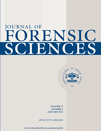The Use of a 3-D Laser Scanner to Document Ephemeral Evidence at Crime Scenes and Postmortem Examinations
Abstract
Abstract: Proper documentation of physical evidence at both crimes scenes and postmortem examination is crucial for downstream analysis, interpretation, and presentation in court. Ephemeral or transient evidence poses particular challenges to investigators, as its very nature renders it difficult or impossible to seize and maintain in its original physical state. The use of a hand-held three-dimensional (3-D) laser scanner is proposed to capture and document such evidence, both in the field and at autopsy. Advantages of the scanner over traditional means of documentation such as photography or casting include the ability to obtain measurements in all dimensions, the ability to reconstruct missing elements, and the ease with which generated images can be interpreted by the jury at trial. Potential scenarios warranting the use of the scanner are identified, and the limitations of its use are discussed.




